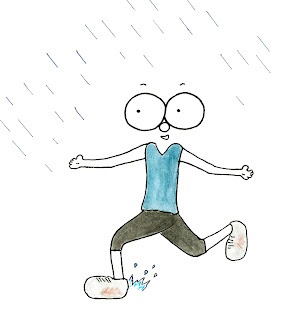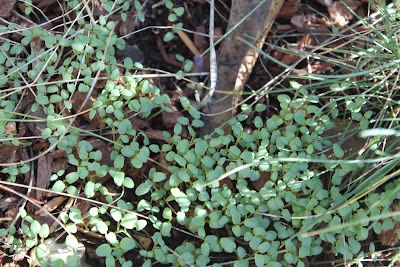He'd brushed against my huge 'Purple Haze' Aster chilensis, which is admittedly encroaching on the footpath, and the feathery substance was seeds. In terms of house cleaning enthusiasm, mine doesn't even register, so I found the seed intrusion to be quite a pain-in-the-aster, so to speak, and it nudged me to reach the decision to take the plant out. I'm not a big remover of plants that I've selected, because I have a sentimental streak 20 miles wide, but I've been ambivalent about this one all summer, due to the unexpected way it grew. About this time last year it was getting a bit ragged looking, and I thought if I cut it way down it would grow back nice and fresh, but the cut-down part actually never did grow back. Instead, a ring of aster grew up around the perimeter of the old clump. Aster spreads by rhizomes (vigorously) so it just moved outward and came up to surround the old part. It made for kind of an odd feature--a kind of aster vortex that swallowed up the cat a few times.
 So what the heck, time to move on. Another motivation to oust it is that way back in the early summer, I was possessed by a moment of summer fever and purchased a very non-native dwarf lime tree. I normally don't buy non-natives, but if it's something tasty that can go in my tummy, I sometimes make an exception, and I have a little pot of mint as well, so Mojito fairies must have been dancing in my head.
So what the heck, time to move on. Another motivation to oust it is that way back in the early summer, I was possessed by a moment of summer fever and purchased a very non-native dwarf lime tree. I normally don't buy non-natives, but if it's something tasty that can go in my tummy, I sometimes make an exception, and I have a little pot of mint as well, so Mojito fairies must have been dancing in my head.But then I realized I didn't really have a very sunny spot for the lime, so it stayed in its 5 gallon nursery pot all season. Now I guess it will move in where the aster moves out. It should be a good spot, because it's next to my outrageously heavy St. Francis birdbath that I manage to heave over daily in the summer in order to maintain a reputable towhee and finch spa, and that daily water-dump should suit that pesky non-native fruit. Now I just hope the little tree doesn't freeze during the winter. It's always something was these fussy not-hardy-Californians!
I'll have to think of some pretty, lower-growing natives to underplant the lime with. Also, I don't mean to paint the aster in a bad light. It was a lovely plant when it was blooming:
When I get out ol' Spod (Swinging Pick of Doom) and chop out all those rhizomes, I'll transplant them up on the still rather bare Hill of Doom, a sunny and out-of-hose-reach little slope I haven't really done much with yet. If I have blooming asters up there next spring, it'll be awesome--I'll report back if I do!








